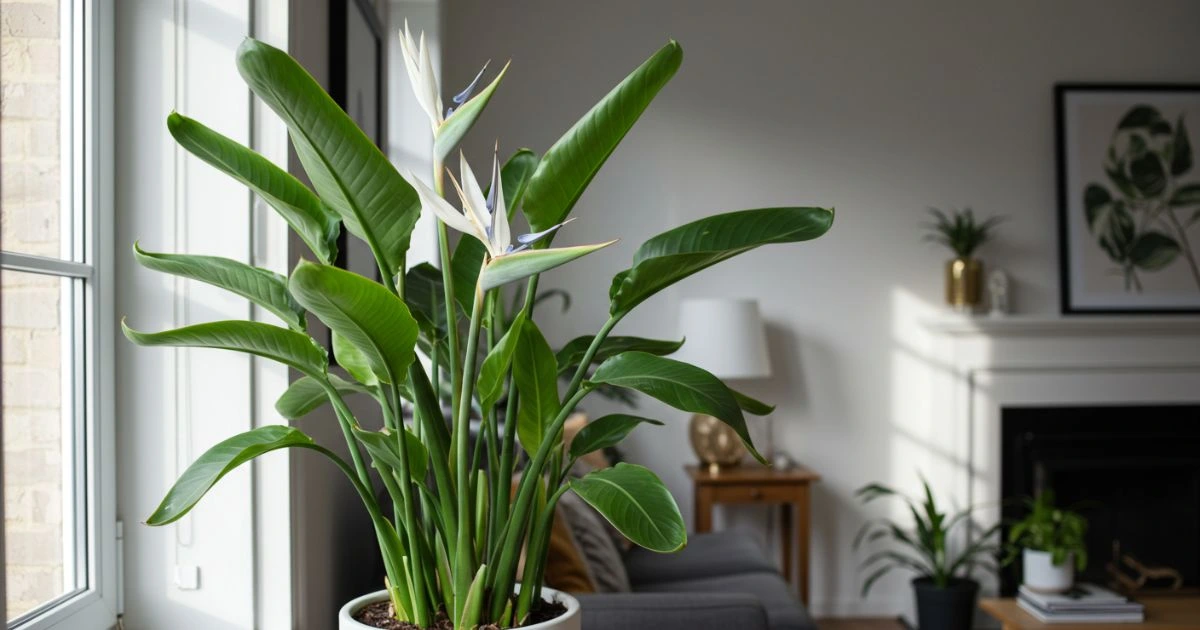In This Article
Are you dreaming of bringing a touch of the tropics into your home or garden? The white bird of paradise offers striking beauty and a lush, exotic vibe that transforms any space. But how do you keep this majestic plant thriving? This guide dives into the essentials of white bird of paradise care, ensuring your plant grows healthy and vibrant. Whether you’re a seasoned gardener or just starting, these easy tips will help you connect with your plant and enjoy its incredible charm for years to come.
| Common Name | White Bird of Paradise |
| Botanical Name | Strelitzia nicolai |
| Family | Strelitziaceae |
| Plant Type | Evergreen Perennial |
| Mature Size | 6–20 feet tall (outdoors), 3–6 feet (indoors) |
| Bloom Time | Rare indoors; spring to summer outdoors |
| Toxicity | Toxic to pets (cats and dogs) |
| Sun Exposure | Bright, indirect light; tolerates partial shade |
| Soil Type | Well-draining, rich, slightly sandy |
| Soil pH | 6.0–7.0 (slightly acidic to neutral) |
| Flower Color | White with a blue tongue |
| Hardiness Zones | USDA 10–12 |
| Native Area | South Africa |
| Temperature | Prefers 65–80°F; avoid drafts and extreme cold. |
| Repotting | Every 2–3 years; best done in spring. |
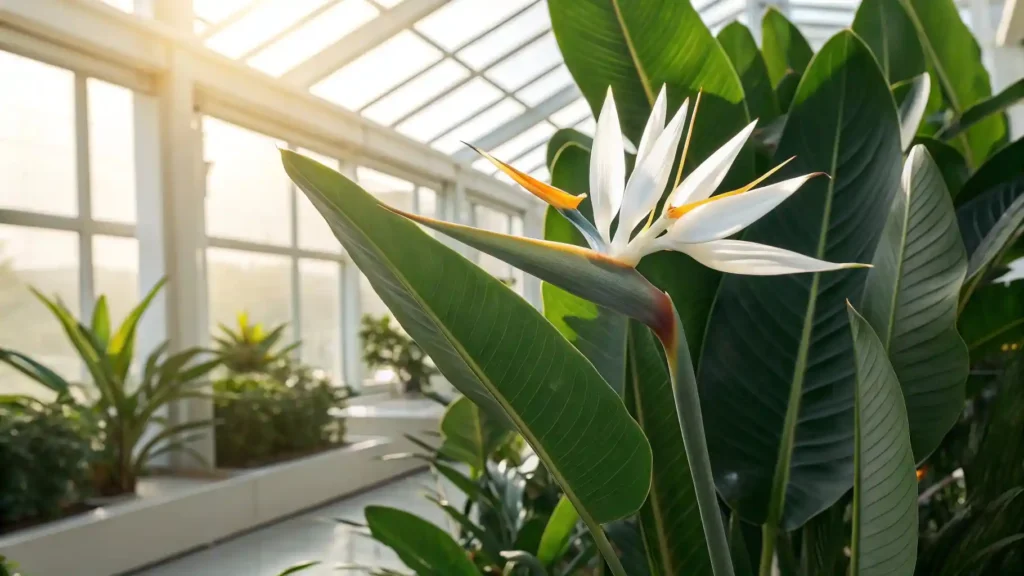
What Is the White Bird of Paradise?
The white bird of paradise (Strelitzia nicolai) is a stunning tropical plant known for its large, glossy leaves and dramatic white flowers resembling a bird in flight. Native to South Africa, this striking plant thrives in warm climates and adds an exotic touch to any space. Whether grown indoors as a statement piece or outdoors in suitable zones, its ability to create a lush, tropical vibe makes it a favorite among gardeners.
In outdoor settings, the white bird of paradise can reach heights of up to 20 feet, but when grown indoors, it typically stays more compact, making it a versatile choice for different environments. It’s also valued for its air-purifying properties, enhancing both the aesthetics and health of your home or garden.
Understanding the basics of white bird of paradise care ensures that this majestic plant stays vibrant and thrives in any setting.
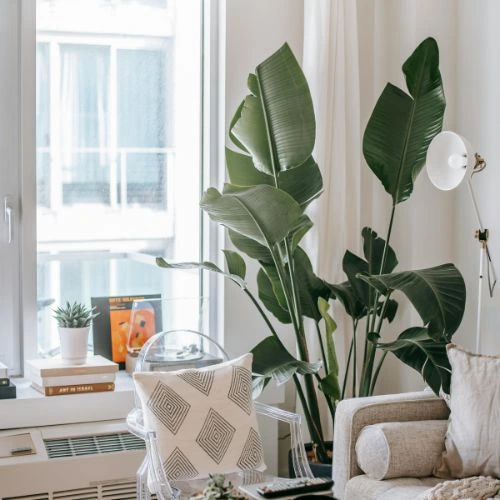
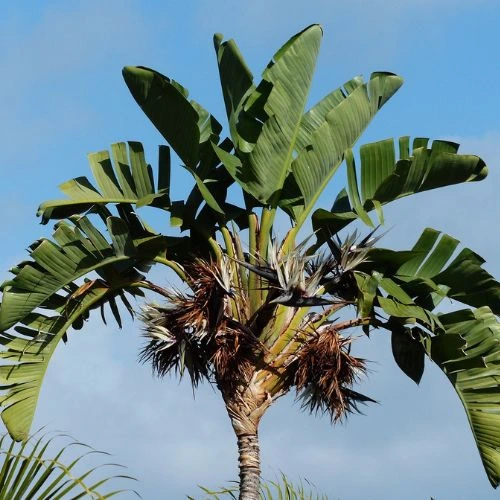
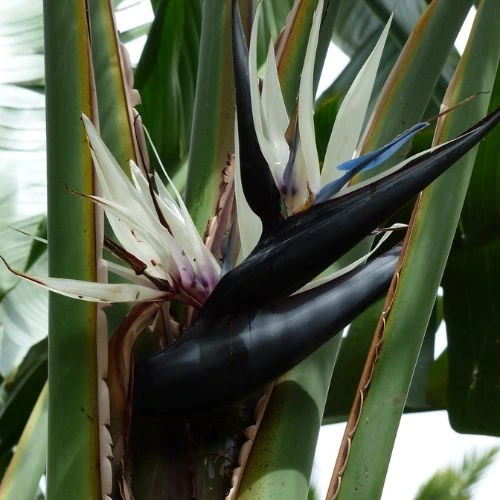
Choosing the Right Location
One of the most important aspects of white bird of paradise care is choosing the perfect spot to ensure your plant thrives. Whether grown indoors or outdoors, the right location can make all the difference.
Indoor Placement
For indoor white bird of paradise care, choose a location with bright, indirect sunlight. South or east-facing windows are ideal, but avoid harsh direct sun, which can scorch the leaves. The plant thrives in temperatures between 65°F and 80°F and prefers high humidity levels. To maintain moisture, mist the leaves regularly or use a humidifier, especially during winter when indoor air is dry.
Outdoor Placement
If growing your plant outdoors, pick a spot with partial shade or filtered sunlight to prevent leaf burn. Ensure the soil is well-draining, as soggy roots can lead to problems like root rot. A slightly acidic to neutral pH (6.0–7.0) is ideal for optimal growth. Protect the plant from strong winds to prevent the leaves from tearing.
By providing the right conditions indoors or outdoors, your white bird of paradise will grow healthy and strong, showcasing its iconic beauty.
Watering Tips
Proper watering is essential for effective white bird of paradise care. This tropical plant enjoys moist but not soggy soil, so it’s important to strike a balance.
Water deeply, allowing the top 2 inches of soil to dry out before watering again. During the active growing season (spring and summer), keep the soil consistently moist. However, reduce watering during the dormant winter months when the plant requires less hydration.
Watch for signs of overwatering, such as yellowing leaves and a mushy base, which could indicate root rot. On the other hand, drooping leaves may suggest underwatering. To avoid issues, always use a pot with drainage holes and discard excess water from the saucer.
By mastering your watering routine, you can keep your white bird of paradise happy, ensuring lush foliage and healthy growth year-round.
Fertilizing Essentials
To ensure vibrant growth and healthy blooms, fertilizing is a key part of white bird of paradise care. To keep this it happy, feed it regularly throughout spring and summer.
Opt for a balanced, slow-release fertilizer, ideally with an NPK ratio like 10-10-10. Apply it every 6–8 weeks, following the package instructions for the right dosage. Alternatively, a liquid fertilizer diluted to half strength can be applied monthly. Fertilizers rich in nitrogen promote lush foliage, while phosphorus aids in flower production.
Avoid over-fertilizing, as it can lead to salt buildup in the soil, which harms the roots. If you notice white crusts on the soil surface, flush the soil with water to wash away excess salts. Organic options like compost or fish emulsion are also great eco-friendly choices that improve soil health naturally.
During fall and winter, stop fertilizing as the plant enters dormancy. Overfeeding during this time can stress the roots. By providing proper nutrients at the right time, your white bird of paradise will grow strong and beautiful, whether indoors or in your garden.
Pruning and Maintenance
Regular pruning and maintenance are vital for effective white bird of paradise care. Pruning not only keeps the plant tidy but also encourages healthy growth and prevents disease.
Start by removing any yellowing or dead leaves. Use sterilized pruning shears to cut them at the base, ensuring you don’t damage healthy tissue. Similarly, trim away spent flower stalks to direct the plant’s energy into new growth.
In order to remove dust and improve photosynthesis, wipe the leaves regularly with a damp cloth. This simple step helps the plant absorb more light, keeping the foliage glossy and vibrant. Additionally, clean leaves reduce the risk of pests settling on your plant.
Inspect your plant monthly for signs of disease or pests like spider mites and scale insects. Catching these problems early makes them easier to address.
For outdoor plants, remove debris around the base to discourage pests and maintain airflow. Indoor plants may need more frequent dusting and occasional misting to mimic a humid environment.
Consistent pruning and care will keep your white bird of paradise looking its best, ready to be the tropical centerpiece of your space.
Most faced Problems and How to Solve Them
Even with proper white bird of paradise care, your plant may face challenges. Knowing how to identify and address these problems will keep it thriving.
1. Pests
Most observed pests include spider mites, mealybugs, and scale insects. Signs of infestation include tiny webs, sticky residue, or discolored spots on leaves. Treat pests with insecticidal soap or neem oil, applying weekly until the problem resolves. Regularly cleaning leaves can help prevent future infestations.
2. Diseases
Root rot is a major concern caused by overwatering. Prevent it by ensuring your soil is well-draining and avoiding waterlogged conditions. Leaf spot, a fungal issue, appears as brown or black spots with yellow halos. Get rid of affected leaves and improve airflow around the plant.
3. Growth Issues
If your plant isn’t flowering, it may need more light or has not yet reached maturity (typically 3–5 years). Drooping leaves are often a sign of underwatering or temperature stress. Adjust your care routine accordingly.
4. Troubleshooting Checklist:
- Yellowing leaves: Overwatering or poor drainage.
- Brown leaf edges: Low humidity or underwatering.
- Split leaves: Natural but worsened by low humidity or rough handling.
By monitoring your plant and responding quickly to problems, you can maintain a healthy, vibrant white bird of paradise year-round.
Repotting the White Bird of Paradise
Repotting is a crucial part of white bird of paradise care, ensuring your plant has room to grow and thrive.
When to Repot
Repot your plant every 2–3 years or when roots start circling the pot’s edges. Signs that it’s time to repot include slowed growth and roots emerging from the drainage holes. Choose to repot during Spring as it aligns with the plant’s active growth phase.
How to Repot
- Choose a pot 2–3 inches larger than the current one with proper drainage holes.
- Fill the bottom with fresh, well-draining soil mixed with perlite or sand.
- Gently remove the plant from its old pot, loosening any tangled roots.
- Place the plant in the new pot, filling around it with soil while keeping the base level with the topsoil.
- Water thoroughly and let it drain completely.
Post-Repotting Care
Keep the plant in a bright, indirect light spot and maintain consistent watering to help it adjust. Avoid fertilizing for the first month to prevent stress.
Repotting allows the white bird of paradise to continue growing strong and ensures it remains a stunning focal point in your home or garden.
FAQs
How long does it take for the white bird of paradise to flower?
Indoors, it may take 3–5 years for the plant to mature enough to bloom, and even then, flowering is rare without optimal light and care.
Is the white bird of paradise toxic to pets?
Yes, if ingested, this plant is toxic to cats and dogs. To ensure their safety, be cautious to put it out of reach of pets.
Can I grow it outdoors in colder climates?
In zones colder than USDA 10–12, grow the plant in a pot and bring it indoors during winter to protect it from frost.
- To encourage uniform growth, rotate the plant regularly.
- Use a humidifier indoors during dry seasons to mimic tropical conditions.
- Keep pets away, as it is mildly toxic if ingested.
Conclusion
White bird of paradise care doesn’t have to be complicated. By following the tips in this guide, you’ll enjoy a healthy, vibrant plant that becomes a stunning focal point in your space. Ready to elevate your gardening journey? Subscribe to our newsletter for exclusive tips and expert advice to help your garden flourish!

